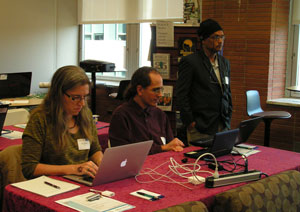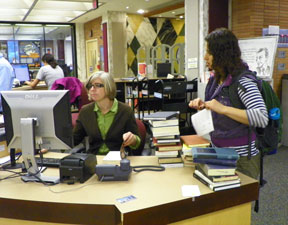By Luisa Cywinski
During the October semester break at Villanova University, the Tech Trifecta, a series of three technology-centered conferences, was held in Falvey Memorial Library and welcomed librarians and technologists from all over the world, including Nepal, Portugal, Germany and Norway.

Code{4}Lib presenters, l. to r. Chris Hallberg, Kathryn Lynch, Demian Katz, Karen Coombs, Mohan Raj Pradhan, John Mark Ockerbloom, Michelle Suranofsky, Daria Norris.
The Trifecta consisted of the VuFind Summit, Code4Lib Mid-Atlantic and VuStuff III. All three events focused heavily on technology although VuStuff offered an integrated view of technology and scholarly communication, including the work of Villanova professors and librarians.
The VuFind Summit brought together current and potential VuFind developers, some of whom presented on projects that rely on VuFind to enhance online accessibility of library resources. Demain Katz, technology development specialist, also previewed VuFind 2.0 and facilitated a detailed discussion of the new release.
Code4Lib, according to their wiki, is an online community of “hackers, designers, architects, curators, catalogers, artists and instigators from around the world, who largely work for and with libraries, archives and museums on technology ‘stuff.'” Participants gathered at our University for the inaugural Mid-Atlantic conference, which included in-depth presentations from nearby universities, like Drexel University and The University of Pennsylvania, and from faraway places, like HealthNet Nepal in Kathmandu, Nepal.

(l. to r.) Michael Mafodda, Dr. Judith Giesberg, Joe Lucia, Rebecca Capobianco, Ruby Johnson
Of interest to both scholars and technologists, the VuStuff conference focuses on the intersections between technology and scholarly communications. As a departure from previous VuStuff conferences, a Villanova history professor, Judith Giesberg, PhD, delivered a presentation on the use of Web resources, specifically the “Emilie Davis Diaries in the Classroom.” Her graduate students, Rebecca Capobianco and Ruby Johnson, co-presented with her. Michael Mafodda, Communication Department, assisted with multimedia production of the project.
Rebecca Goldman, LaSalle University, won the Vuie Award for Best Presentation for her talk on the preservation of digital materials.
As noted by Joe Lucia, University librarian, the week reflected the enormous “investment of time and energy” on the part of the Tech Trifecta planning team. Their aim was to provide a central location for “valuable conversations,” said Lucia.
Members of Falvey’s Technology team and Digital Library team, David Uspal, Demian Katz, Michael Foight, David Lacy, Laura Bang and Stephen Spatz all collaborated with colleagues from other institutions to make the Tech Trifecta a huge success.
Additional support of the event was provided by Falvey’s Scholarly Outreach Team staff, Gina Duffy, Marie Roman, and Communication & Publication Team staff, Laura Hutelmyer, Luisa Cywinski and Alice Bampton. Advance web and print publicity, as well as printed materials for each conference, were created by Joanne Quinn, Falvey graphic designer.

(l. to r.) Karen Coombs, Demian Katz and Mohan Raj Pradhan
Using one of the new spaces in the Library, the Speakers’ Corner, Falvey was able to accommodate up to 100 guests, with comfortable seating, suitable furniture for laptop, tablet, and mobile devices and plentiful power strips. Some attendees made use of social media to chronicle their experience. (Search Twitter for the hashtags #VuFind2012, #c4lma, and #VuStuff2012.) Many of the presentations were recorded and can be found on the individual conference websites.
Photographss by Alice Bampton & Laura Hutelmyer










 Over the course of six Saturdays this past spring, our team used photography, poetry, and installation to reclaim the sites where the riots occurred. The blocks surrounding the intersection of American Street and Master Street in the Kensington neighborhood of Philadelphia reveal no physical traces of their past. No buildings from that time survived the Riots or the neighborhood’s subsequent industrialization and deindustrialization, and no plaques mark the sites. By re-envisioning the past and overlaying personal experiences onto the blank canvas of this landscape, the project asked both participants and the public to interrogate our assumptions about who we are and where we come from.
Over the course of six Saturdays this past spring, our team used photography, poetry, and installation to reclaim the sites where the riots occurred. The blocks surrounding the intersection of American Street and Master Street in the Kensington neighborhood of Philadelphia reveal no physical traces of their past. No buildings from that time survived the Riots or the neighborhood’s subsequent industrialization and deindustrialization, and no plaques mark the sites. By re-envisioning the past and overlaying personal experiences onto the blank canvas of this landscape, the project asked both participants and the public to interrogate our assumptions about who we are and where we come from.